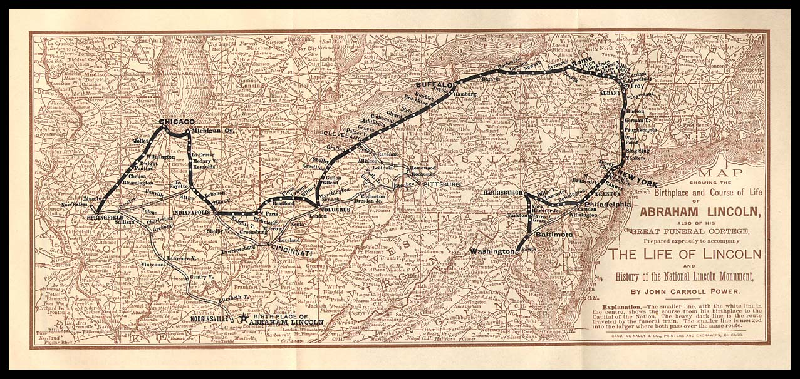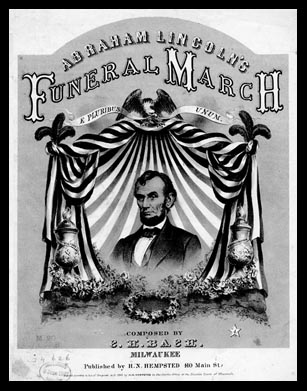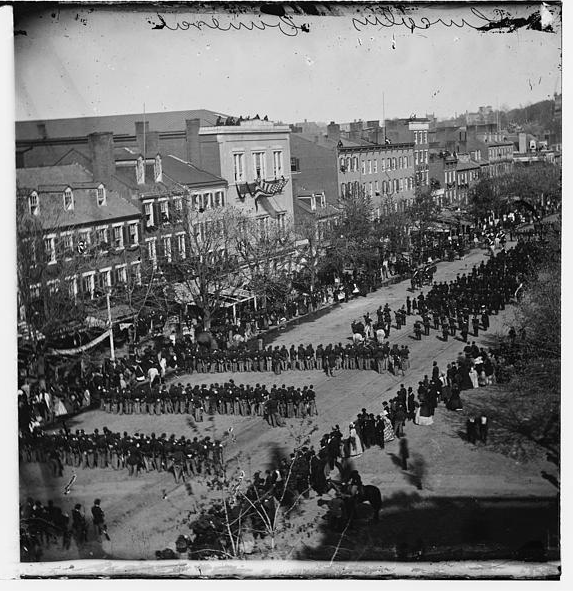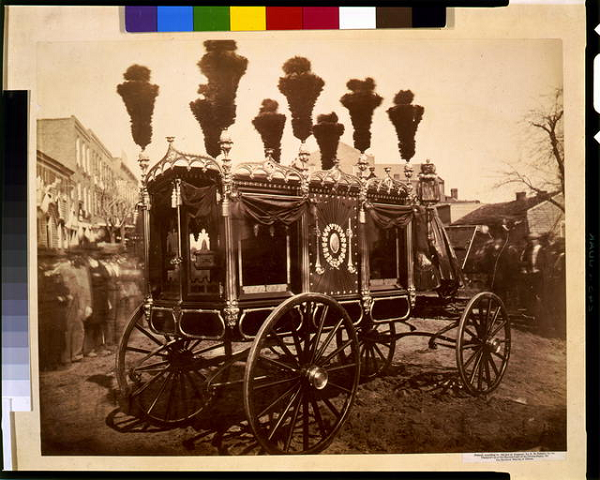
On the evening of April 14, 1865, an assassin shot President Abraham Lincoln. He died the next day at 7:22 a.m. While Union soldiers hunted the conspirators, the nation went into mourning. The funeral for the assassinated president took place April 19, 1865 at the White House. The New York Times reported that “thousands wended their way up the capitol steps, into the grand rotunda, by the bier and coffin of the President… their homage was silent and tearful.” On the morning of April 21, a military guard placed Lincoln’s casket in the ninth car of a funeral train which was draped in black. The casket of Lincoln’s son William who had died in 1862 was also aboard for the trip back to the Midwest.

The train, which also carried friends, family, high ranking officials, and a military guard, left Washington D.C. destined for Lincoln’s home town of Springfield, Illinois, on April 21. The War Department directed the procession which declared the tracks along the route to be “military roads.” On April 30 the Lincoln funeral train passed into Indiana where Lincoln spent much of his youth (1816-1830). The War Department directed: “The route from Columbus to Indianapolis is via the Columbus and Indianapolis Railroad, and from Indianapolis to Chicago via Lafayette and Michigan Railroad. In order to guard against accidents, trains will not run faster than twenty miles per hour.”
The train stopped in Richmond first, at 3 a.m., to the sound of tolling bells and a crowd of somewhere between 12,000 and 15,000 people. Here, Governor Oliver P. Morton and almost 100 elected officials paid their respects. The governor and other several other high-ranking officials boarded the train for the trip to the state capital.

At 3:41 a.m. the train arrived in Centreville, home town of Congressmen George W. Julian, a steadfast abolitionist and supporter of women’s rights. Next it passed through Germantown and Cambridge City, home of Union General Solomon Meredith. As the train passed through Dublin at 4:27 a.m., almost the entire town was standing on the platform in the rain. Next the train stopped in Lewisville and afterwards it slowed as it passed through the small village of Charlottesville, where reportedly a large number of African Americans gathered in mourning. The train passed through Greenfield at 5:55 a.m. and then paused in Cumberland on the Hancock-Marion county border.

The train reached Indianapolis on April 30 at 7 a.m. in the pouring rain. The city was decorated with arches, evergreens, and flags. The Indianapolis city band played the Lincoln Funeral March while soldiers moved the casket to the hearse. The hearse, which was an ornately decorated carriage drawn by six plumed white horses, delivered the casket from the train to the State House through streets lined with people. The Indianapolis Daily Gazette noted “the archways and mourning festoons across the streets, the public and private buildings draped in the habiliments of grief, the funeral procession, the solemn dirges, and, above all, the patient multitude that stood for hours in the drenching rain waiting an opportunity to look upon the earthly tenement so lately vacated by the spirit.”

The coffin was placed in the interior hall of the State House which was lined in black cloth. The Indianapolis Guard of Honor protected the flower-surrounded coffin. The Indianapolis Daily Gazette estimated that 15,000 troops and 60,000 private citizens passed through the rotunda that day. Rain prevented the elaborate ceremonial procession from the State House back to the train depot which had been planned for that evening. Instead, the casket lay in state until 10 p.m., which was longer than planned, and then the hearse carried the casket directly back to the train depot. Mourning Hoosiers followed the carriage and the train left Indianapolis at midnight.
It passed through Augusta, Zionsville, Whitestown, Lebanon, Hazelrigg, Thorntown, Colfax, and Stockwell, before reaching Lafayette. The New York Semi-Weekly Times reported on the trip through these towns: “These are small places, but it seems the inhabitants are on the roadside. Some of them hold torches in their hands, and the surroundings are solemnly lighted. Men stand with uncovered heads as the train hurries on its way.” At Lebanon the residents “hung over the track, suspended from two uprights, a hundred variegated Chinese lanterns.”
The train reached Lafayette at 3:35 a.m. and the Indianapolis Daily Journal reported that in Lafayette “The houses on each side of the railroad is [sic] illuminated, and; as elsewhere, badges of mourning and draped flags are displayed; bonfires are blazing and bells tolling; mournful strains of music are heard, and the people are assembled at all the stations to view the train.” After leaving Lafayette, the train traveled through Tippecanoe Battle Ground, Brookston, Chalmers, Reynolds, Bradford, Francisville, Medaryville, Kankakee, La Crosse, Wanatha, Westville, and Lacroix.

The train reached Michigan City at 8:25 a.m. The Indianapolis Daily Journal reported that it “stopped under a large and beautiful temporary structure, trimmed with black and white and ornamented with evergreens and choice flowers.” The arches were decorated with black and white fabric, evergreens, and flowers. Over each arch were the words “Abraham Lincoln” and a motto. These included, “Our guiding star has fallen” and “Though dead he yet speaketh.” Young women sang the hymn “Old Hundred.” The Times reported, “Many persons are affected to tears.” The paper concluded its description of the Michigan City stop: “Meantime, guns are fired, and the subduing strains of music are heard. The scene is gilded by an unclouded sun.” The Chicago Tribune reported that the morning was “clear and beautiful.”
Finally, it had stopped raining.
Read about the train’s journey to Chicago and then to Lincoln’s home of Springfield, where the President was laid to rest, here.
